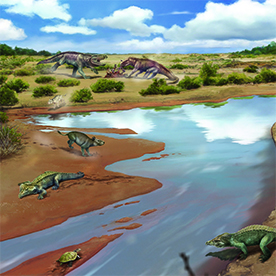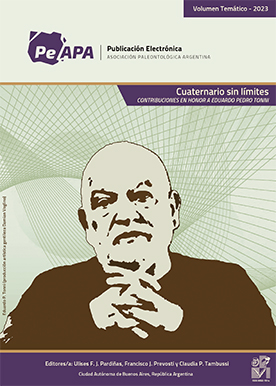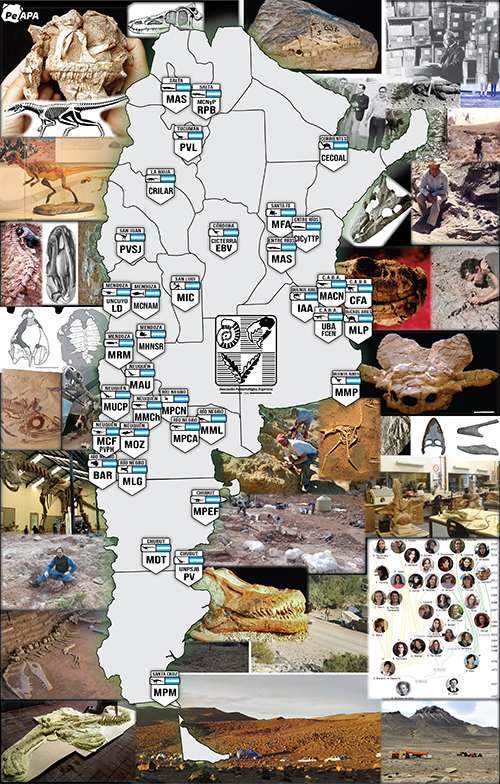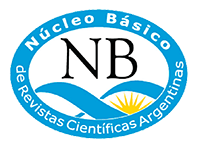THE RÍO LORO FORMATION (PALEOGENE, NORTHWESTERN ARGENTINA) AND ITS UNIQUE VERTEBRATE FAUNA: EXPLORING PALEOENVIRONMENTAL AND PALEOECOLOGICAL ASPECTS
DOI:
https://doi.org/10.5710/PEAPA.02.07.2024.509Keywords:
Sedimentology, Fluvial system, Fossil herpetofauna, Paleoecology, Pan-PerissodactylaAbstract
Paleoenvironmental and paleoecological aspects of the Río Loro Formation (Paleogene, northwestern Argentina) were analyzed. In the type locality, four main sedimentary facies were recognized. Facies 1 (coarse-grained to pebbly amalgamated sandstones) record sedimentation in braided channels. Facies 2 (structureless to faintly laminated mudstones) and Facies 3 (interbedded mudstones with sandstones) are ascribed to deposition in distal to proximal floodplain settings, respectively. Facies 4 (coarse to medium-grained sandstone) is interpreted as deposited in meandering channels. Insect trace fossils, ascribed to nesting structures, were recognised particularly in facies 1 and 4. The recognized facies were grouped in a main facies association which allows interpretating a deposition in a complex multi-channel fluvial system with relatively stable muddy floodplain areas. Within this system, seasonal humid to dryer conditions favored biota substrate colonization and soil-forming processes. Well-preserved mammalian and reptilian remains were recognized in sandy mudstone deposits of Facies 3, showing low weathering stages (mainly stages 1 and 2) and the absence of signs of abrasion. These aspects, along with the presence of some articulated remains and their integration
with the paleoenvironmental framework, suggest that skeletal pieces suffered an early burial after partial disarticulation, possibly by splays during major floods. The inferred habits of some of the taxa recorded are consistent with proximity to freshwater sources, vegetated areas, and
seasonality. This multidisciplinary approach contributes to the understanding of paleoenvironmental and paleontological attributes of the Río Loro Formation and represents a basis for future surveys on this unit and its remarkable fossil record.
References
Abascal, L. (2005). Deformación andina en la cuenca de Choromoro. NO de Tucumán: estilo estructural combinado. Revista Asociación Geológica Argentina, 60, 268–277.
Allen, J. R. L. (1965). A review of the origin and characteristics of recent alluvial sediments: Sedimentology, 5, 89–191.
Allen, J. R. L. (1973). Features of cross-stratified units due to random and other changes in bedforms. Sedimentology, 20, 189–202.
Alonso, R. N. (1992). Estratigrafía del Cenozoico de la cuenca de Pastos Grandes (Puna salteña) con énfasis en la Formación Sijes y sus boratos. Revista de la Asociación Geológica Argentina, 47, 189–199.
Andrews, E., White, T., & del Papa, C. (2017). Paleosol-based paleoclimate reconstruction of the paleocene-eocene thermal maximum, northern Argentina. Palaeogeography, Palaeoclimatology, Palaeoecology, 471, 181–195.
Armella, M. A., Alonso, G. E., García-López, D. A., Croft, D. A., & Muruaga, C. (2024). Systematics and biostratigraphic inferences on a new notoungulate assemblage (Mammalia, Pan-Perissodactyla) from the India Muerta Formation (Late Miocene), Northwestern Argentina. Publicación Electrónica de la Asociación Paleontológica Argentina, 24(1), 44–70.
Babot, M. J., Aceñolaza, G., Carrizo, H. A., & García-López, D. A. (2018). El registro fósil de la Puna. In H. R. Grau, M. J. Babot, A. Izquierdo, & A. Grau (Eds.), La Puna Argentina: Naturaleza y Cultura (pp. 117–140). Fundación Miguel Lillo.
Babot, M. J., García-López, D. A., Deraco, M. V., Herrera, C. M., & del Papa, C. (2017). Mamíferos paleógenos del subtrópico de Argentina: síntesis de estudios estratigráficos, cronológicos y taxonómicos. In C. M. Muruaga & P. Grosse (Eds.), Ciencias de la Tierra y Recursos Naturales del NOA. Relatorio del XX Congreso Geológico Argentino (pp. 730–753). Asociación Geológica Argentina.
Behrensmeyer, A. K. (1978). Taphonomic and ecological information from bone weathering. Paleobiology, 4, 150–162.
Behrensmeyer, A. K., (1982). Time resolution in fluvial vertebrate assemblages. Paleobiology, 8, 211–227
Behrensmeyer, A. K. (1988). Vertebrate preservation in fluvial channels. Palaeogeography, Palaeoclimatology, Palaeoecology, 63, 183–189.
Behrensmeyer, A. K. (1991). Terrestrial vertebrate accumulations. Topics in Geobiology, 9, 291–335.
Behrensmeyer, A. K., Potts, R., Plummer, T. W., Tauxe, L., Opdyke, N., & Jorstad, T. (1995). The Pleistocene locality of Kanjera, Western Kenya: Stratigraphy, chronology and paleoenvironments. Journal of Human Evolution, 29, 247–274.
Bergqvist, L. P., Powell, J. E., & Avilla, L. S. (2004). A new Xenungulate from the Rio Loro Formation (Paleocene) from Tucumán province (Argentina). Ameghiniana, 41(4), 36 R.
Bonaparte, J. F. & Morales, J. (1997). Un primitivo Notonychopidae (Litopterna) del Paleoceno inferior de Punta Peligro, Chubut, Argentina. Estudios Geológicos, 53(5–6), 263–274.
Bond, M. & Vucetich, M. G. (1983). Indalecia grandensis gen. et sp nov. del Eoceno temprano del Noroeste argentino, tipo de nueva la Subfamilia de los Adianthidae (Mammalia, Litopterna). Asociación Geológica Argentina, 28(1), 107–117.
Bossi, G. E. (1969). Geología y estratigrafía del sector sur del valle de Choromoro. Acta geologica lilloana, 10, 17–64.
Bossi, G. E. & Peral, M. A. (1992). Terminación austral de la cuenca del Grupo Salta. IV Reunión Argentina de Sedimentología (pp. 175–182). Actas.
Bossi, G. E., Gavriloff, I. J., & Esteban, G. I. (1998). Terciario. Estratigrafía, Bioestratigrafía y Paleogeografía. In M. Gianfrancisco, M. E. Puchulu, J. Durango de Cabrera, & G. F. Aceñolaza (Eds.), Geología de Tucumán (pp. 87–108). Colegio de Graduados en Ciencias Geológicas de Tucumán.
Bravo, G. G. & García-López, D. A. (2023). Nuevos ejemplares de Sebecidae (Crocodyliformes, Notosuchia) para la Formación Río Loro, Paleógeno del noroeste argentino. Libro de resúmenes 36 Jornadas Argentinas de Paleontología de Vertebrados (p. 32). La Rioja.
Bravo, G. G., Pol, D., & García-López, D.A. (2021). A new sebecid mesoeucrocodylian from the Paleocene of northwestern Argentina. Journal of Vertebrate Paleontolology, 41(3), e1979020.
Bridge, J. S. (2006). Fluvial facies models: Recent developments. In H. Posamentier & R. G. Walker (Eds.), Facies models revisited (pp. 85–170). SEPM Special Publication 84.
Bro-Jørgensen, J. (2008). Dense habitats selecting for small body size: a comparative study on bovids. Oikos, 117(5), 729–737.
Buatois, L. A., Mangano, M. G., & Aceñolaza, F. G. (1996). Icnofaunas paleozoicas en sustratos ¢rmes no marinos: evidencias del Pérmico de la cuenca Paganzo. Ameghiniana, 33(3), 265–270.
Burns, C. E., Mountney, N. P., Hodgson, D. M., & Colombera, L. (2017). Anatomy and dimensions of fluvial crevasse-splay deposits: examples from the cretaceous Castlegate sandstone and Neslen formation, Utah. U.S.A. Sedimentary Geology, 351, 21–35.
Burns, C. E., Mountney, N. P., Hodgson, D. M., & Colombera, L. (2019). Stratigraphic architecture and hierarchy of fluvial overbank splay deposits. Journal of the Geological Society, 176(4), 629–649.
Carrapa, B. & DeCelles, P. G. (2008). Eocene exhumation and basin development in the Puna of northwestern Argentina. Tectonics, 27(1), TC1015.
Ciancio, M., Herrera, C., Aramayo, A., Payrola, P., & Babot, M. J. (2016). Diversity of cingulates (Mammalia, Xenarthra) in the middle-late Eocene of Northwestern Argentina. Acta Palaeontologica Polonica, 61, 575–590.
Cifelli, R. L. (1993). The phylogeny of the native South American ungulates. In F. S. Szalay, M. J. Novacek, & M. C. McKenna (Eds.), Mammal Phylogeny, Placentals, (pp. 195–216). Springer-Verlag.
Collinson, J. D. (1996). Alluvial sediments. In H. G. Reading (Ed.), Sedimentary Environments: processes, facies, stratigraphy. 3rd edition, (pp. 37–82). Blackwell Science.
Collinson, J. & Mountney, N. (2019). Sedimentary structures (Fourth edition). Dunedin Academic Press.
Croft, D. A., Gelfo, J. N., & López, G. M. (2020). Splendid innovation: the extinct South American native ungulates. Annual Review of Earth and Planetary Sciences, 48, 259–290.
de Broin, F. & de la Fuente, M. S. (1993). Les tortues fossiles d’Argentine: synthéses. Annales de Paléontologie, 79(3), 169–232.
de la Fuente, M. S., Maniel, I. J., Ruiz, P. G., Ledesma, J., Deraco, M. V., del Papa, C., & Herrera, C. (2022). A new podocnemidid (Pleurodira: Pelomedusoides) from the Eocene of north-western Argentina, with comments on its evolutionary relationships and palaeoenvironmental settings. Journal of Systematic Palaeontology, 20(1), 2081939.
del Papa, C. E. (2006). Estratigrafía y paleoambientes de la Formación Lumbrera, Grupo Salta, noroeste argentino. Revista de la Asociación geológica Argentina, 61(3), 313–327.
del Papa, C. E. & Salfity, J. A. (1999). Non-marine Paleogene sequences, Salta Group, northwest Argentina. Acta Geológica Hispánica, 34, 105–122.
del Papa, C. E., García, V., & Quattrocchio, M. (2002). Sedimentary facies and palynofacies assemblage in Eocene perennial lake, Lumbrera Formation, Northwest Argentina. Journal of South American Earth Sciences, 15, 553–569.
del Papa, C., Babot, M. J., Dahlquist, J., García-López, D. A., Deraco, V., Herrera, C., Bertelli, S., Rougier, G. W., & Giannini, N. P. (2022). Toward a chronostratigraphy of the Paleocene-Eocene sedimentary record in northwestern Argentina. Journal of South American Earth Sciences. https://doi.org/10.1016/j.jsames.2021.103677
Fielding, C. R. (2006). Upper flow regime sheets, lenses and scour fills: extending the range of architectural elements for fluvial sediment bodies. Sedimentary Geology, 190, 227–240.
Fisher, J. A., Nichols, G. J., & Waltham, D. A. (2007). Unconfined flow deposits in distal sectors of fluvial distributary systems: examples from the Miocene Luna and Huesca Systems, northern Spain. Sedimentary Geology, 195(1–2), 55–73.
Fortelius, M. & Solounias, N. (2000). Functional characterization of ungulate molars using the abrasion-attrition wear gradient: a new method for reconstructing paleodiets. American Museum Novitates, 3301, 1–36.
García-López, D. A., Saade, L. S, Babot, M. J., & Alonso-Muruaga, P. J. (2022). Nuevos especímenes de Satshatemnus bonapartei Soria 1989 (Mammalia) permiten una reinterpretación de la especie en el marco de la fauna de la Formación Río Loro (Paleógeno, provincia de Tucumán). Libro de Resúmenes de la Reunión de Comunicaciones de la Asociación Paleontológica Argentina (p. 164). Salta.
Gasparini, Z., Fernandez, M., & Powell, J. (1993). New tertiary sebecosuchians (Crocodylomorpha) from South America: phylogenetic implications. Historical Biology, 7(1), 1–19.
Gelfo, J. N., García-López, D. A., & Bergqvist, L. P. (2020). Phylogenetic relationships and palaeobiology of a new xenungulate (Mammalia: Eutheria) from the Palaeogene of Argentina. Journal of Systematic Palaeontology, 18(12), 993–1007.
Georgieff, S. M., Ibañez, L. M., Vides, M. E., Anis, K., & Nieva, S. (2014). Paleógeno y Neógeno de Tucumán: estratigrafía y paleoambientes sedimentarios. In S. Moyano, M. E. Puchulu, D. S. Fernández, S. Nieva, & G. Aceñolaza (Eds.), Geología de Tucumán (pp. 106–123). Colegio de Graduados en Ciencias Geológicas de Tucumán.
Ghosh, P., Sarkar, S., & Maulik, P. (2006). Sedimentology of a muddy alluvial deposit: Triassic Denwa Formation, India. Sedimentary Geology, 191, 3–36.
Gibling, M. R. (2006). Width and thickness of fluvial channel bodies and valley fills in the geological record: a literature compilation and classification. Journal of sedimentary Research, 76(5), 731–770.
González, O. E., Viruel, M. E., Mon, R., Tchilinguirian, P., & Barber, E. L. G. (2000). Hoja Geológica 2766-II San Miguel de Tucumán. Boletín N◦ 245. Dirección Nacional del Servicio Geológico.
Hasiotis, S.T. (2002). Continental trace fossils. SEPM Short Course Notes, 51, 1–132.
Kiehl, J. T., Shields, C. A., Snyder, M. A., Zachos, J. C., & Rothstein, M. (2018). Greenhouse-and orbital-forced climate extremes during the early Eocene. Philosophical Transactions of the Royal Society A: Mathematical, Physical and Engineering Sciences, 376(2130), 20170085.
Klappa, C. F. (1980). Rhizoliths in terrestrial carbonates: classification, recognition, genesis, and significance. Sedimentology, 26, 613–629.
Kramarz, A. G., Bond, M., & Rougier, G. W. (2017). Re-description of the auditory region of the putative basal astrapothere (Mammalia) Eoastrapostylops riolorense. Systematic and phylogenetic considerations. Annals of Carnegie Museum, 84, 99–167.
Kraus, M. J. (1996). Avulsion deposits in lower Eocene alluvial rocks, Bighorn Basin, Wyoming. Journal of Sedimentary Research, 66, 354–363.
Kraus, M. J. (1999). Paleosols in clastic sedimentary rocks: their geologic applications. Earth-Science Reviews, 47(1–2), 41–70.
Kraus, M.J. (2002). Basin-scale changes in floodplain paleosols: implications
for interpreting alluvial architecture. Journal of Sedimentary Research, 72,
–509.
Kraus, M. J. & Hasiotis, S. T. (2006). Significance of different modes of rhizolith preservation to interpreting paleoenvironmental and paleohydrologic settings: examples from Paleogene paleosols, Bighorn Basin, Wyoming, USA. Journal of Sedimentary Research, 76(4), 633–646.
Lapiana, A. T., del Papa, C. E., & Gaiero, D. (2016). Los depósitos limolíticos eocenos de la Formación Lumbrera superior (Salta, Argentina): discusión sobre el posible origen eólico. Latin American Journal of Sedimentology and Basin Analysis, 23, 71–90.
Lunt, I. A., & Bridge J. S. (2007). Formation and preservation of open-framework gravel strata in unidirectional flows. Sedimentology 54, 71–87
MacFadden, B. J. (2000). Middle Pleistocene climate change recorded in fossil mammal teeth from Tarija, Bolivia, and upper limit of the Ensenadan Land-Mammal Age. Quaternary Research, 54, 121–131.
Mack, G. H., James, W. C., & Monger, H. C. (1993). Classification of paleosols.
Geological Society of America Bulletin, 105, 129–136.
Madden, R. H. (2015). Hypsodonty in mammals. Cambridge: Cambridge University Press.
Makaske, B. (2001). Anastomosing rivers: a review of their classification, origin and sedimentary products. Earth-Science Reviews, 53, 149–196.
Martin, S. (2008). Global diversity of crocodiles (Crocodilia, Reptilia) in freshwater. Hydrobiologia, 595, 587–591.
Miall, A. D. (1985). Architectural-element analysis: a new method of facies analysis applied to fluvial deposits. Earth-Science Reviews, 22(4), 261–308.
Miall, A. D. (1996). The geology of fluvial deposits. Sedimentary Facies, Basin Analysis, and
Petroleum Geology. New York: Springer-Verlag.
Miall, A. D. (2010). Alluvial deposits. In N. P. James & R. W. Dalrymple (Eds.), Facies Models 4 (pp. 105–138). GEOtext 6, Geological Association of Canada.
Mon, R., Gutierrez, A; Abascal, L., Sàbat, F., & Iaffa, D. (2014). Estructura cenozoica de la Provincia de Tucumán. In S. Moyano, M. E. Puchulu, D. S. Fernández, S. Nieva, & G. Aceñolaza (Eds.), Geología de Tucumán (pp. 106–123). Colegio de Graduados en Ciencias Geológicas de Tucumán.
Montero‐López, C., del Papa, C., Hongn, F., Strecker, M. R., & Aramayo, A. (2018). Synsedimentary broken‐foreland tectonics during the Paleogene in the Andes of NW Argentine: new evidence from regional to centimetre‐scale deformation features. Basin Research, 30, 142–159.
Nanson, G. C. (1980). Point bar and floodplain formation of the meandering Beatton River, northeastern British Columbia, Canada. Sedimentology, 27, 3–29.
Nascimento, D. L., Batezelli, A., & Ladeira, F. S. B. (2017). First record of lobed trace fossils in Brazil's Upper Cretaceous paleosols: rhizoliths or evidence of insects and their social behavior? Journal of South American Earth Sciences, 79, 364–376.
Nascimento, D. L., Batezelli, A., & Ladeira, F. S. B. (2019). The paleoecological and paleoenvironmental importance of root traces: Plant distribution and topographic significance of root patterns in Upper Cretaceous paleosols. Catena, 172, 789–806.
Nichols, G. (2009). Sedimentology and stratigraphy. West Sussex: John Wiley & Sons.
Ortiz Jaureguizar, E. & Cladera, G. A. (2006). Paleoenvironmental evolution of southern South America during the Cenozoic. Journal of Arid Environments, 66, 498–532.
Pascual, R., Bond, M., & Vucetich, M. G. (1981). El Subgrupo Santa Bárbara (Grupo Salta) y sus vertebrados, cronología, paleoambientes y paleobiogeografía. Actas 8◦ Congreso Geológico Argentino (pp. 743–758). San Luis.
Paula Couto, C. de (1963). Um Trigonostylopidae do Paleoceno de Brazil. Anais Academia Brasileira de Ciencias, 35(3), 339–351.
Pol, D. & Powell, J. E. (2011). A new sebecid mesoeucrocodylian from the Río Loro Formation (Palaeocene) of north-western Argentina. Zoological Journal of the Linnean Society, 163, 7–36.
Powell, J. E. & Ortiz, P. E. (2014). Los vertebrados fósiles de la provincia de Tucumán. In S. Moyano, M. E. Puchulu, D. S. Fernández, S. Nieva, & G. Aceñolaza (Eds.), Geología de Tucumán (pp. 208–227). Colegio de Graduados en Ciencias Geológicas de Tucumán.
Powell, J. E., Palma, R. M. (1981). Primer hallazgo de mamíferos en la Formación Río Loro, provincia de Tucumán y su significado cronológico. Revista de la Asociación Geológica Argentina, 26, 208–212.
Powell, J. E., Babot, M. J., García López, D. A., Deraco, M. V., & Herrera, C. M. (2011). Eocene vertebrates of northwestern Argentina: annotated list. In J. A. Salfity & R. A. Marquillas (Eds.), Cenozoic Geology of the Central Andes of Argentina (pp. 349–370). SCS Publisher.
Retallack, G. J. (1988). Field recognition of paleosols, in Reinhardt, J., and Sigleo, W.R., eds., Paleosols and Weathering through Geologic Time: Principles and Applications Geological Society of America Special Paper, 216, 1–20.
Retallack, G. J. (2001). Soils of the past: an introduction to paleopedology (Second Edition). Blackwell Science.
Saade, L. S., García-López, D. A., & Armella, M. A. (2023b). Variación intraespecífica en Eoastrapostylops riolorense Soria 1981 (Mammalia), un ungulado de la Formación Río Loro (Paleógeno, provincia de Tucumán). Libro de resúmenes 36 Jornadas Argentinas de Paleontología de Vertebrados (pp. 77–78). La Rioja.
Saade, L. S., García-López, D. A., Babot, M. J., Alonso-Muruaga, P. J., & Alonso, G. E. (2023a). First record of Indalecia (Mammalia, Litopterna?, Indaleciidae) in the Río Loro Formation (early Paleogene, Tucumán Province, Argentina). Publicación Electrónica de la Asociación Paleontológica Argentina, 23(2), 134–145.
Salfity, J. A. & Marquillas, R. A. (1994). Tectonic and sedimentary evolution of the cretaceous-eocene Salta group basin, Argentina. In J. A. Salfity (Ed.), Cretaceous Tectonics of the Andes, Earth Evolution Sciences (pp. 266–315). Friedr. Vieweg & Sohn.
Schap, J. A. & Samuels, J. X. (2020). Mesowear analysis of the Tapirus polkensis population from the Gray Fossil Site, Tennessee, USA. Palaeontologia Electronica, 23(2), 1–16.
Simpson, G. G. (1937). New reptiles from the Eocene of South America. American Museum Novitates, 927, 1–3.
Smith, R. M. H. (1993). Vertebrate taphonomy of late permian floodplain deposits in the
southwestern karoo Basin of South Africa. Palaios, 8, 45–67.
Soria, M. F. (1984). Notopterna: un nuevo orden de mamíferos ungulados del Terciario inferior de Sudamérica. Resúmenes de las 1° Jornadas Argentinas de Paleontología de Vertebrados (p. 23). La Plata.
Soria, M. F. (1989a). El primer Notoungulata de la Formación Río Loro (Paleoceno medio), provincia de Tucumán, República Argentina. Ameghiniana, 26(3–4), 145–151.
Soria, M. F. (1989b). Notopterna: un nuevo orden de mamíferos ungulados eógenos de América del Sur. Parte II: Notonychops powelli gen. et sp. nov. (Notonychopidae nov.) de la Formación Río Loro (Paleoceno medio), provincia de Tucumán, Argentina. Ameghiniana, 25(3), 259–272.
Soria, M. F. & Powell, J. E. (1981). Un primitivo Astrapotheria (Mammalia) y edad de la Formación Río Loro, provincia de Tucumán, República Argentina. Ameghiniana, 18(3–4), 155–168.
Zachos, J. C., Dickens, G. R., & Zeebe, R. E. (2008). An early Cenozoic perspective on greenhouse warming and carbon-cycle dynamics. Nature, 451, 279–283.
Zimicz, A. N., Fernández, M., Bond, M., Chornogubsky, L., Arnal, M., Cárdenas Zapata, S., Sobel, E. R., del Papa, C., Muruaga, C., & Zhou, R. (2019). Miocene fragmentation of the Central Andean foreland basins between 26 and 28 S. Journal of South American Earth Sciences, 94, 102238.

Additional Files
Published
Versions
- 2024-10-17 (2)
- 2024-10-16 (1)
Issue
Section
License
Copyright (c) 2024 Pablo Joaquín Alonso-Muruaga, Luis Sebastián Saade, Gonzalo Gabriel Bravo, Guido Ezequiel Alonso, María Judith Babot, Daniel Alfredo García-López

This work is licensed under a Creative Commons Attribution-NoDerivatives 4.0 International License.

Authors retain copyright and grant the journal right of first publication with the work simultaneously licensed under a CC Attribution-NonCommercial 4.0 that allows others to share the work with an acknowledgement of the work's authorship and initial publication in this journal.






















